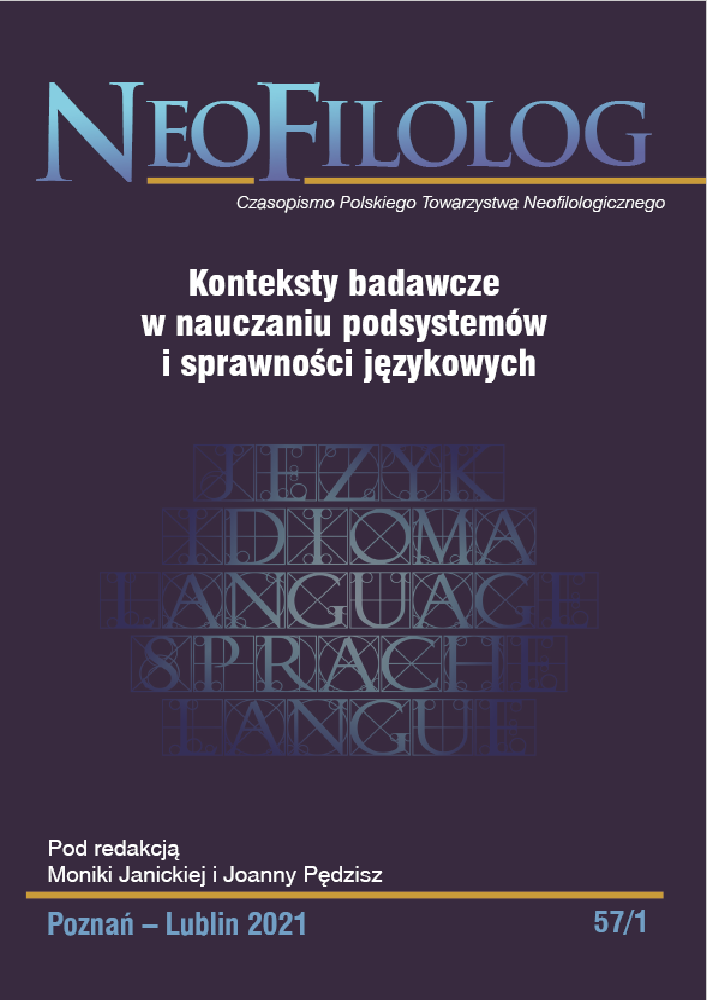Résumé
In today's world interactions between language learners take place not only in a direct form but also online. Online communication requires adequate forms of teaching, one of which can be learning through virtual exchanges. This article shows how this form of learning allows the use of skills characteristic of online interactions defined in the CEFR Companion Volume. The research herein presented is based on data collected during a Polish-Italian virtual exchange. The quantitative and qualitative analysis of A1 level Italian students' statements gathered during the project showed that participation in the virtual exchange was an opportunity for learners to use various skills related to online conversation and discussion defined in the CERF Companion Volume. The results also show that the number of statements created by the learners was significantly higher than the minimum necessary to complete the assigned tasks. Furthermore, the students demonstrated many online interaction skills assigned to the A2 level, thus exceeding the level of their Italian language proficiency. On this basis, it can be concluded that virtual exchanges are an engaging form of learning for students, even at the beginner level, which allows them to realize their potential for communicating in the target language with the use of online interaction skills.
Références
Belz J. A. (2003), From the Special Issue Editor. „Language Learning & Technology”, nr 7(2), s. 2–5. Online: http://dx.doi.org/10125/25193 [DW 08.09.2021].
Bérešová J., Micallef A. (2020), Online Interaction Descriptors: A Tool for the Development of Tasks for Language Competences and Language Use. „Journal of Language and Cultural Education”, nr 8(3), s. 60–74. Online: https://sciendo.com/pdf/10.2478/jolace-2020-0020 [DW 08.09.2021].
Cinganotto L. (2019), Online Interaction in Teaching and Learning a Foreign Language: an Italian Pilot Project on the Companion Volume to the CEFR. „Journal of e-Learning and Knowledge Society”, nr 15(1), s. 135–151. Online: https://www.je-lks.org/ojs/index.php/Je-LKS_EN/article/view/1618/1040 [DW 08.09.2021].
Chun D. M. (2011), Developing Intercultural Communicative Competence through Online Exchanges. „CALICO Journal”, nr 28(2), s. 392–419. Online: https://www.jstor.org/stable/calicojournal.28.2.392?seq=1#metadata_info_tab_contents [DW 08.09.2021].
Common European Framework of Reference for Languages: Learning, Teaching, Assessment. Companion Volume with New Descriptors (2018). Strasburg: Rada Europy. Online: https://rm.coe.int/cefr-companion-volume-with-new-descriptors-2018/1680787989 [DW 08.09.2021].
Common European Framework of Reference for Languages: Learning, Teaching, Assessment. Companion Volume with New Descriptors (2020). Strasburg: Rada Europy. Online: https://rm.coe.int/common-european-framework-of-reference-for-languages-learning-teaching/16809ea0d4 [DW 08.09.2021].
Cunningham J., Vyatkina, N. (2012), Telecollaboration for Professional Purposes: Towards Developing a Formal Register in the Foreign Language Classroom. „The Canadian Modern Language Review”, nr 68, s. 422–450. Online: https://www.academia.edu/5020996/Telecollaboration_for_Professional_Purposes_Towards_Developing_a_Formal_Register_in_the_Foreign_Language_Classroom [DW 08.09.2021].
Europejski system opisu kształcenia językowego: uczenie się, nauczanie, ocenianie. Warszawa: Wydawnictwa Centralnego Ośrodka Doskonalenia Nauczycieli, 2003. Online: https://www.ore.edu.pl/wp-content/uploads/attachments/ESOKJ_Europejski-System-Opisu.pdf [DW 08.09.2021].
Dunne B. (2014), Reflecting on the Japan-Chile Task-Based Telecollaboration Project for Beginner-Level Learners. „TESL Canada Journal/Revue TESL du Canada”, nr 31(8), s. 175-186. Online: https://teslcanadajournal.ca/index.php/tesl/article/download/1193/1013/ [DW 08.09.2021].
Fuchs C. (2019), Critical Incidents and Cultures-of-use in a Hong Kong-Germany Telecollaboration. „Language Learning & Technology”, nr 23(3), 74–97. Online: https://www.lltjournal.org/item/3122 [DW 08.09.2021].
Gadomska A. (2019), Applying the CEFR Descriptors for Online Interaction and Mediation for the Design of Moodle Based TEFL Materials. „E-learning”, nr 11, s. 473–481. Online: https://us.edu.pl/wydzial/wsne/wp-content/uploads/sites/20/Nieprzypisane/29-APPLYING-THE-CEFR-DESCRIPTORS...-1.pdf [DW 08.09.2021].
Guth S., Helm F. (2012), Developing Multiliteracies in ELT Through Telecollaboration. „ELT Journal”, nr 66(1), s. 42–51. Online: https://www.researchgate.net/publication/273370405_Developing_multiliteracies_in_ELT_through_telecollaboration [DW 08.09.2021].
Helm F. (2014), Developing Digital Literacies Through Virtual Exchange. „eLearning Papers”, nr 38, s. 43–52. Online: https://www.academia.edu/12657065/Developing_digital_literacies_through_virtual_exchange [DW 08.09.2021].
Janowska I. (2015), Europejski system opisu kształcenia językowego – treści i funkcje dokumentu, (w:) Lipińska E., Seretny A. (red.), Umiejętność rozumienia i tworzenia tekstów w świetle „Standardów wymagań egzaminacyjnych” oraz „Europejskiego systemu opisu kształcenia językowego”: monografia zbiorowa. Kraków: Księgarnia Akademicka, s. 17–30. Online: https://ruj.uj.edu.pl/xmlui/bitstream/handle/item/16141/janowska_europejski_system_opisu_ksztalcenia_jezykowego_2015.pdf?sequence=1&isAllowed=y [DW 08.09.2021].
Janowska I. (2020), Mniej niż A1…, czyli o kompetencjach użytkownika języka na poziomie pre-A1, (w:) Dąbrowski A., Kucharczyk R., Leńko-Szymańska A., Sujecka-Zając J. (red.), Kompetencje XXI wieku: certyfikacja biegłości językowej = Competences of the 21st Century: Certification of Language Proficiency. Warszawa: Wydawnictwa Uniwersytetu Warszawskiego, s. 57–79.
Langé G., Cinganotto L., Benedetti F. (2020), Interazione online: una sperimentazione italiana. „Italiano LinguaDue”, nr 1, s. 603–612. Online: https://riviste.unimi.it/index.php/promoitals/article/view/13948/13090 [DW 08.09.2021].
Lewis T., O’Dowd R. (2016), Introduction to Online Intercultural Exchange and This Volume, (w:) Lewis T., O’Dowd R. (red.), Online Intercultural Exchange. Policy, Pedagogy, Practice. Abingdon: Routledge, s. 3–20.
North B., Piccardo E. (2019), Developing New CEFR Descriptor Scales and Expanding the Existing Ones: Constructs, Approaches and Methodologies. „Zeitschrift Für Fremdsprachenforschung”, nr 30(2), s. 143–161. Online: https://www.dgff.de/assets/Uploads/ZFF-2-2019-01-North-Piccardo.pdf [DW 08.09.2021].
Schenker T. (2012), Intercultural Competence and Cultural Learning Though Telecollaboration. „CALICO Journal”, nr 29, s. 449–470. DOI: 10.11139/cj.29.3.449-470. Online: https://journals.equinoxpub.com/CALICO/article/download/23720/19725 [DW 08.09.2021].
Licence
© Anna Pieczka 2021

Ce travail est disponible sous licence Creative Commons Attribution - Pas de Modification 4.0 International.
Auteurs :
Les auteurs de textes acceptés pour publication dans la revue Neofilolog sont tenus de remplir, signer et renvoyer à l'adresse de la rédaction, un accord sur l'octroi d'une licence gratuite pour les œuvres, avec obligation d'accorder une sous-licence CC.
En vertu de cet accord, les auteurs des textes publiés dans la revue Neofilolog accordent à l'Université Adam Mickiewicz de Poznań une licence non exclusive et gratuite et permettent l'utilisation de la sous-licence Creative Commons Attribution-NoDerivatives 4.0 International (CC BY-ND 4.0).
Les auteurs se réservent le droit de disposer librement de l'œuvre.
Utilisateurs :
Les utilisateurs d'Internet intéressés ont le droit d'utiliser les œuvres publiées à partir de l'année 2017 sous réserve des conditions suivantes :
- reconnaissance de la qualité d'auteur - l'obligation de fournir des informations sur la qualité d'auteur, le titre, la source (liens vers l'œuvre originale, DOI) et la licence, ainsi que l'œuvre distribuée ;
- sans créer d'œuvres dérivées - l'œuvre doit être conservée dans sa forme originale, p. ex. les traductions ou les interprétations ne peuvent être distribuées sans le consentement de l'auteur.
Tous les textes publiés sont soumis au droit d'auteur.
Autres :
L'Université Adam Mickiewicz de Poznań se réserve le droit à la revue dans son ensemble (mise en page, forme graphique, titre, conception de la couverture, logo, etc.).
.

